Irapuato, Guanajuato 作者: 来源: 发布时间:2021-11-15
1.Population and Area
Pop: 380,941 (city)
Area: 845.16 km2
Elev: 1724 masl
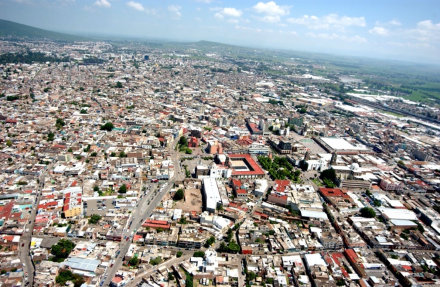
Irapuato location in Mexico within the state of Guanajuato
https://goo.gl/maps/8bYgvDoVsAmKS5F36
2. Natural geography
Geography
The city is settled for the most part on flat terrain, whose average slope is 1 to a thousand. Within this area there are two forms of relief:
1) Flat Region: With height above sea level from 1,716,614 to 1,724,452 meters and comprises 85% of the total area, with an average slope of 1 to a thousand.
2) Rough terrain: It covers approximately 15% of the surface of the study area, located on the periphery of the area composed of hills and hills, among which are Cerro de Arandas, Bernalejo, Blanco and Loma Pelada.
Hydrography
The Municipality of Irapuato is in hydrological region No. 12 "€ œLerma-Chapala-Santiago" €; This region is divided into six basins, and the municipality is located in the "B" Lerma Salamanca river basin, which drains an area of 10,391,665 km2. This 12 "B" basin has its origin in the Solís dam, so the municipality of Irapuato is benefited by several irrigation channels. There is the "La Purísima" dam. Likewise, there are three dams to control rivers: La Gavia, Chichimequillas and El Conejo II.
Fauna
The mammals that proliferate in the place are the following: gopher, shrew, zacatuche, forest mouse, and volcano rat; having also birds of which you can see: quail, chuparrosa, roadrunner, chupamirto, nightingale, sparrow, nuthatch and heron.
Nature and weather
Köppen Classification: Humid Subtropical Climate
This climate is characterized by relatively high temperatures and evenly distributed precipitation throughout the year. This climate type is found on the eastern sides of the continents between 20° and 35° N and S latitude. In summer, these regions are largely under the influence of moist, maritime airflow from the western side of the subtropical anticyclonic cells over low-latitude ocean waters. Temperatures are high and can lead to warm, oppressive nights. Summers are usually somewhat wetter than winters, with much of the rainfall coming from convectional thunderstorm activity; tropical cyclones also enhance warm-season rainfall in some regions. The coldest month is usually quite mild, although frosts are not uncommon, and winter precipitation is derived primarily from frontal cyclones along the polar front.
The Köppen Climate Classification subtype for this climate is "Cfa". (Humid Subtropical Climate).
The average temperature for the year in Irapuato is 68.5°F (20.3°C). The warmest month, on average, is May with an average temperature of 75.2°F (24°C). The coolest month on average is January, with an average temperature of 61.2°F (16.2°C).
The highest recorded temperature in Irapuato is 107.8°F (42.1°C), which was recorded in May. The lowest recorded temperature in Irapuato is 26.6°F (-3°C), which was recorded in January.
The average amount of precipitation for the year in Irapuato is 26.6" (675.6 mm). The month with the most precipitation on average is July with 6.4" (162.6 mm) of precipitation. The month with the least precipitation on average is February with an average of 0.2" (5.1 mm). In terms of liquid precipitation, there are an average of 71.7 days of rain, with the most rain occurring in July with 15.7 days of rain, and the least rain occurring in March with 1.1 days of rain.
https://www.weatherbase.com/weather/weather-summary.php3?s=911028&cityname=Irapuato%2C+Guanajuato%2C+Mexico&units=
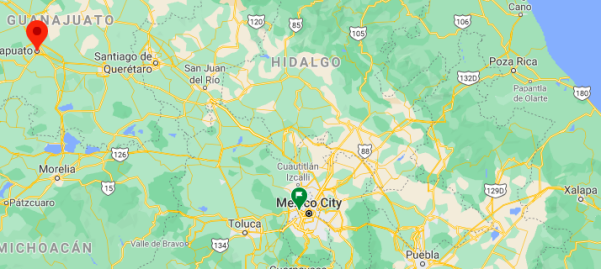
Getting there and around
Get there
By air – Del Bajío International (BJX) is the Leon/ Guanajuato Airport is about 40 minutes away from Irapuato and has several flights a day from the US.
By car – The quickest way to get from Mexico City to Irapuato is to drive which costs $550 - $850 and takes 3h 23m.
By bus – The cheapest way to get from Mexico City to Irapuato is to bus which costs $440 - $600 and takes 5h 6m. There are services departing from Izazaga and arriving at Irapuato via Mexico Norte. The journey, including transfers, takes approximately 6h 18m.
https://www.rome2rio.com/s/Mexico-City/Irapuato
Car Rental – To explore Mexico’s provincial towns and cities—including its beach locations and the scenery and attractions near them— consider renting a car for your visit. Having your own car will give you more flexibility than using public transport options and, in some cases, offer you access to places which are otherwise difficult to visit without the use of a car.
COVID19 – International entry into Mexico from United States
Allowed for: All visitors arriving by air. Mexico land borders are closed to non-essential travel
Restricted for: There are no current restrictions.
Get around
Local Buses – Local buses and mini-buses (combis or micros) are available locally for a fraction of the cost of a taxi around town. You need to speak Spanish to be able to ask for directions or ask the driver to tell you where to get off.
Taxis – Taxis in most of Mexico’s towns and cities are not metered, so agree your price before you get in. Taxi travel is very affordable in Mexico, in comparison to the USA, Canada and Europe, and so provides a viable means of public transportation in Mexico. Your hotel can arrange taxis for you; some post their rates on a board in the lobby; taxi hotel rates are usually higher than cabs you hail off the street. If you speak Spanish, you will have a distinct advantage and be able to negotiate a price with the driver.
Uber is expanding rapidly across Mexico and now offers services in cities across the country, including: Mexico City, Toluca, Cuernavaca, Puebla, Querétaro, León, Aguascalientes, San Luis Potosí, Guadalajara, Monterrey, Hermosillo, Tijuana, Mexicali, and Mérida. Uber has been adding Mexican cities to its network every year, check for availability when you arrive at your destination in Mexico.
Cabify and Didi are also developing and currently operate in cities including Mexico City, Toluca, Monterrey, Puebla, Querétaro and Tijuana. Check for availability in the city you are visiting.
These services offer people with smartphones a way to book a cab through a mobile app for a pre-agreed price. Fares are comparable with Sitio type cabs, and sometimes trade at a premium to this when local demand increases.
https://www.mexperience.com/transport/taxi-travel-in-mexico/#51
3. ECONOMY
GDP: 36 483.4 M MXN (2010)
https://www.researchgate.net/publication/323024442_Estimacion_no-parametrica_del_producto_interno_bruto_de_los_municipios_de_Mexico
4. Industry characteristics
Irapuato is one of the most economically competitive municipalities in the state due to the diversity of its industry, its infrastructure and its offer of services. Irapuato is responsible for a significant percentage of the total state industry.
At the national level, Guanajuato ranks third as a producer in the textile industry and at the state level it stands out as the main textile manufacturer and exporter with a percentage of 62% of the state's annual textile production, surpassing cities with traditional textile industries, Moroleón and Uriangato, which stand out only in regional trade.
Recently, with the arrival of the automotive industry and the creation of new industrial parks, Irapuato resumed its growth, because although some of these transnational companies are located in Silao, 70% of the workforce comes from Irapuato, both administrative and operating . Currently, these companies contribute the 2nd largest part of the GDP of the state of Guanajuato, the 1st being agricultural exports.
In parallel, other actions are aimed at positioning the city as a logistics center in Guanajuato. Irapuato is one of the most important commercial exchange centers for various products in the center of the country. Goods that go from the center-south and the Pacific Ocean to the north of the country and to the Gulf and vice versa pass through its territory. It has a very busy and complete road system, seeking synergies between the railway, highway nodes and industrial developments such as the matrix of the Castro del Río Technoindustrial Park that has 1 Campus in Abasolo, the Industrial City of Irapuato, the matrix of the Industrial Park Apolo, which has 2 Campus (Acambaro and Silao), the Guanajuato Industrial Center, the Venado Industrial Park, the Smart Park industrial park and the Central Park of Guanajuato (the latter 2 under construction).
Key project: Irapuato city bypass
The Norponiente Bypass is a high-specification highway that is 29.2 kilometers long. It was built in order to boost the economy of the state of Guanajuato and the region, connecting with the main transportation routes in the Bajío area through its connections with the León-Irapuato and La Piedad-Irapuato federal highway. which facilitates access to the most important cities in the region, León, Guanajuato, Celaya, Querétaro, among others. The average time savings for different regional transfers is 25 minutes.
http://libramientoirapuato.mx
5. Attractions
Strawberry route

If you don’t taste strawberries in all the wide options Irapuato offers, it’s like if you hadn’t been in Strawberry Capital of the World at all.
The tourist information office, located next to the Clock Tower in the main garden, offers the Ruta de la Fresa—as interesting as delicious, it lasts four hours.
The tour begins at this point, early in the morning. The first stop is in one of the fields at the city's outskirts, where the strawberry is grown in huge tubular-shaped nurseries that have the necessary climatic and hygiene conditions for the harvest to be abundant.
There specialists give an explanation about the varieties produced—festival, royal road and salviole, mainly—. Then, you can take a basket to harvest the fruit and taste it at the foot of its origin. Back in the city for lunch, the tour continues in one of the restaurants that include strawberries in their emblematic dishes.
For dessert, the group has an appointment at La Cristalita, a candy store founded by Miguel Miranda in 1965, specializing in the crystallized (sugared, with chili or chocolate), frozen and jams strawberries production.
The visit includes a factory tour with a full explanation of how strawberries are processed according to the different presentations. Conveniently ends at their store, where no one can resist sweet shopping.
Museo de la Ciudad (Museum of the City)
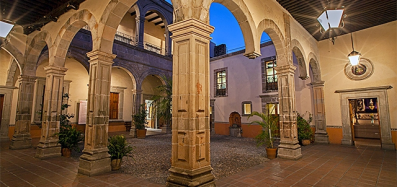
Also known as the Casa de la Inquisición, the building where the Museo de la Ciudad is currently located received that nickname because it was mentioned by Don Genaro Acosta as the place where the offices of the Holy Inquisition operated.
However, according to some versions it actually served as a private residence until the end of the 20th century. Its first owner was the theologian Leandro Barreto de Tábora.
The beautiful 18th century mansion houses, in its three rooms, an interesting collection of archaeological pieces, murals, photos, coins, surgical material, weapons, Porfirian carts and art works.
Peralta Archaeological Site
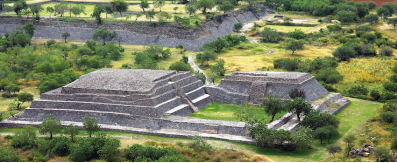
By a currently unknown civilization, the Zona arqueológica de Peralta was inhabited between 300-750 AD.
30 kilometers from Irapuato, on the banks of the Lerma River, the area has a monumental architecture considered one of the greatest expressions of El Bajío—it has six of the eight recorded designs of mound and sunken patio architecture. The site has a curious basalt stone that, when hit, produces a great resonance and which, it’s believed, was used as a communication method among the valley settlements.
Finally, in the Site Museum you’ll find a sample of some archaeological pieces found in the area.
https://www.visitmexico.com/en/guanajuato/irapuato
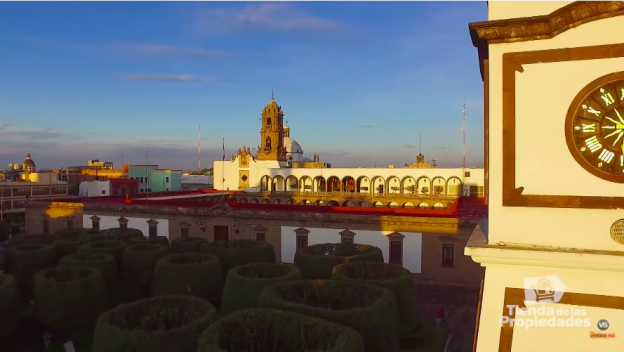
Irapuato 2019 | La Capital Mundial de las Fresas
https://youtu.be/KoIGwdiT_FI
6. History
Prehispanic era
In pre-Hispanic times the settlement was inhabited by the Tarascans. The official appearance of the Spaniards in this land dates back to the 16th century, the century of discoveries and conquests, incredibly accomplished.
The first settlers to arrive in this municipality of Irapuato belonged to the ethnic group called Chichimeca. Later, when this tribe was displaced by the Tarascans, they imposed the name Xiriquitzio or Iriquitzio, a word that the Spanish conquerors pronounced "Jiricuicho". Its Tarascan inhabitants ended up calling it Jiricuato, which means "Hill that emerges from the plains."
Viceroyalty
It was born as a ranch for raising cattle and as an agricultural center due to the fertility of its soils. It became one of the agricultural enclaves of great relevance in the so-called "granary of the new Spain", as well as a great ranch for raising cattle. Its privileged location allowed the first settlers to take advantage of the waters of the Silao River to promote a cereal agriculture detached from the vagaries of storms and ensure stable productivity. Little by little, in the surroundings of Irapuato, estates and ranches were emerging that would supply agricultural products to other cities and mining places in the center and north of New Spain.
On February 15, 1547, Emperor Carlos V granted the founding certificate of the Marian city of Irapuato under the name of Congregation of San Marcos de Irapuato. The names of the founders of the city of Irapuato are the following: Francisco Sixto, Estefano Gamiño, Andrea and Antonio López.
The viceregal authorities shared a sympathy with the families of this city, and in the same way both culture flourished, despotism and slavery. Horticulture and floriculture were a refuge for the natives who were used in large estates, the strawberry plant was imported from France to Mexico in 1849, brought to this city in 1852, by Don Nicolás Tejeda; In total, 24 plants were brought, of which they were placed in a seedbed, on the banks of the Guanajuato River, the uncultivated plants remaining there. It was until 1858 when plantations were acquired and strawberry cultivation began to develop; and even through grafting, obtaining excellent results, especially in the garden of San Antonio de Retana. The commercialization of the strawberry and its intensive cultivation is due to two people: Carlos Drogge and Joaquín Chico González, the latter made the shipments of strawberries to Mexico, having the Central railway line. Currently, Irapuato occupies the first place in the production of strawberries in the State and the second at the national level.
Independence
During the 19th century, Irapuato played an important role. In 1810 at the beginning of the war of independence, the priest Miguel Hidalgo y Costilla, passed through the Congregation of Irapuato and there he prepared to attack Guanajuato, receiving from the population supplies for his army and the adhesion of the Prince's Dragoons regiment, stationed in this population.
During that eventful time Agustín de Iturbide resided in Irapuato and exerted the military command of the Bajío. He arrived at this Congregation in 1812, with the mission of patrolling the roads to safeguard the convoys of merchants from the attacks of the insurgent guerrillas and to pacify the region. One of these guerrillas was Albino García, who attacked the Congregation of Irapuato on five occasions in 1811 and 1812. Iturbide pursued him until he was captured and shot.
The insurgent attack on April 3, 1811 served as the basis for asking the Bishopric of Michoacán that the Virgen de la Soledad be declared patron of the Congregation of Irapuato, because it is said that she protected the lives of the inhabitants.
Porfiriato
Revolutionary armies such as Villistas, Zapatistas, Carrancistas, crossed the city of Irapuato repeatedly, since it always converged on the important railway center.
Mexican Revolution in Irapuato
Due to its geographical and railway location, more than its political position, Irapuato was closely acquainted with some warlike events that took place in the lower corridor, especially in the period of struggle between the constitutionalist forces and the Villistas. The first wave of uprisings linked to the Maderista cause, which occurred in Irapuato, was in charge of the farmer Pedro Covarrubias, who, if he wanted to, could cause serious problems to the state capital and of course to Irapuato. From April 11 to 28, 1912, Irapuato suffered attacks by Zapatista groups, later on July 29, 1914, one of General Álvaro Obregón's outposts from Jalisco under General Ramón V. Sosa and Colonel Miguel Acosta, takes the city of Irapuato, which was defended by the huertistas. In mid-1914, in the midst of the Mexican Revolution, the railway lines were interrupted, causing a shortage of food and other basic necessities, therefore the government establishes certain measures to alleviate this situation. Irapuato receives the First Constitutionalist Chief, Venustiano Carranza.
On April 4, 1915, when the Constitutionalist army occupied Celaya, General Francisco Villa arrived in Irapuato accompanied by his staff and some 20,000 men, his stay was a few days, since two brigades of the Constitutionalists came from Celaya.
On April 21, 1915, General Álvaro Obregón arrived in Irapuato with the bulk of the army of operations in full attack against Villa. Between the days of April 21 to 27 there is an intense movement of railways and people, at the Irapuato station ammunition, food and troops are concentrated, in order to prepare for the battle of Trinidad. Given all this, General Villa tries to isolate the Obregonist hosts and for this he sends Generals Rodolfo Fierro and Canuto the transmission lines from Lagos de Moreno, Jalisco to Irapuato. On July 15, 1915, General Obregón gave the order to General Joaquín Amaro Domínguez to move to the Bajío and leave a garrison in Irapuato, from where he continued the movement of troops in the field against General Rodolfo Fierro.
In 1919, General Álvaro Obregón arrived in Irapuato to present his government plan, since he was a candidate for the Presidency of the Republic. On April 30, 1922, the Bishop of León, Emeterio Valverde y Téllez crowns the Blessed Virgin of Soledad, the patron saint of Irapuato.
Contemporary
The electrification caused astonishment among the population (1900), but it also revolutionized the industry, which until then used steam power. In 1902, hydraulic industrialization was carried out to supply water to the sources and hydrants of the city: towards the year 1907 a branch of the National Bank of Mexico was established. A short time later, on September 29, 1909, the Joaquín Obregón González Market was inaugurated, later called Aquiles Serdán Market (currently it has disappeared). The next day the hospital of Our Lady of Guadalupe enters into operation. As Municipal President Don Agustín Zambrano, the decree on the minimum wage (September 10, 1914) applies, being 75 cents, the 9-hour day. The following year the Sunday rest is established, the vacation period with pay, the obligatory rest on the days of national joust: Holy Thursday and Friday, January 1, December 12 and 25.
In the decade of the twenties there is again a rebound in the industrial activity of irapuatense, new factories and shops appear; making essential the need for essential services for the population. During the Cristero period, Irapuato suffered relatively little, since there was only one armed uprising, which was led by Don Zenón Ayala, a resident of the Santa Ana neighborhood; who was apprehended and shot in the Atrium of the parish. On July 29, 1926, the notification of the suspension of worship services in the state of Guanajuato was received, also ordering the inventory of objects of worship and organizing a meeting of neighbors in charge of closing the temples, something that was never carried out. finished.
During the decade of the forties, the industrial and commercial activity was prepared to cover the needs caused by the Second World War, in this way the cigarette industry tripled its production, also during this stage thousands of irapuatenses braceros were hired to go to work at the agricultural fields of the US state of California, Texas and Illinois. The first strawberry freezers and packers appear.
Starting in the fifties, Irapuato has had a rebound in its economic activity, the extensive strawberry harvest, the freezers, the factories and the trouser and shirt workshops substantially favor the commercial activity both regionally and at the level. national and international, as well as professional services. During this time, beautiful and colorful monuments are built, for example: the National Flag, the Heroes children, the Mother, the National Anthem, Don Vasco de Quiroga, etc.
Elementary, normal, preparatory schools were created. With the implementation of the Guanajuato Plan (1960s), the urban landscape was modified, modernity itself began, department stores were opened to a population of better quality goods; transportation turned in favor of the cars and trucks that arrived at the plant, the railway station goes to a second term after 80 years of activity and that was a determining factor for the economic, industrial, commercial and social development of Irapuato. On August 18, 1973, Irapuato suffered a very severe flood, this phenomenon was repeated frequently due to the abundance of rains, mainly due to the inability to control the catastrophes by the local authorities of the time, after this catastrophe Irapuato grew in population and had the need again to create jobs to reduce the high unemployment rates.
August 18, 1973
On August 18, 1973, a tragic event took place, of great importance in the history of Irapuato, caused by the rupture of the La Llave, La Gavia and El Conejo dams, located upstream of the Silao River. Hundreds of houses were demolished and many people drowned.
Years later, on July 17, 1976, Irapuato was flooded again and, even though it did not have the proportions of that of 1973, the flood caused serious damage in various urban areas.
To avoid new floods, the La Purísima dam was built on the Guanajuato river and the El Conejo dam was rebuilt on the Silao river. Both works allow the control of the rough waters of these rivers.
7.Contact Information

City Mayor: José Ricardo Ortiz Gutiérrez
Contact number: +52 (606) 9999, ext. 1101
Govt. Office Address: Palacio Municipal s/n, Zona Centro, Irapuato, Guanajuato.
FB: https://www.facebook.com/profile.php?id=RicardoOrtizIrap
Twitter: https://twitter.com/Ortiz_Irapuato
Website: http://www.irapuato.gob.mx
